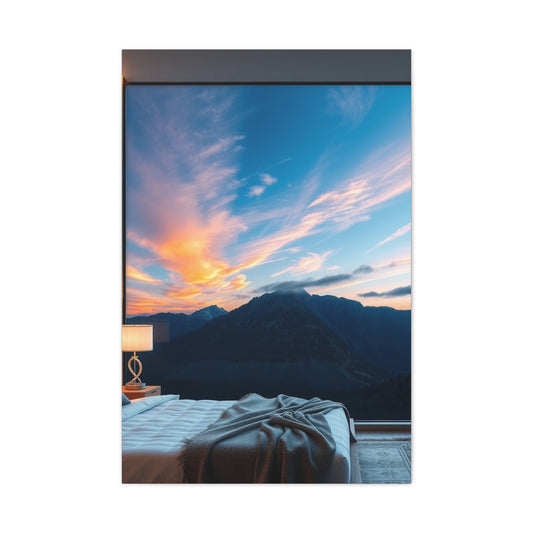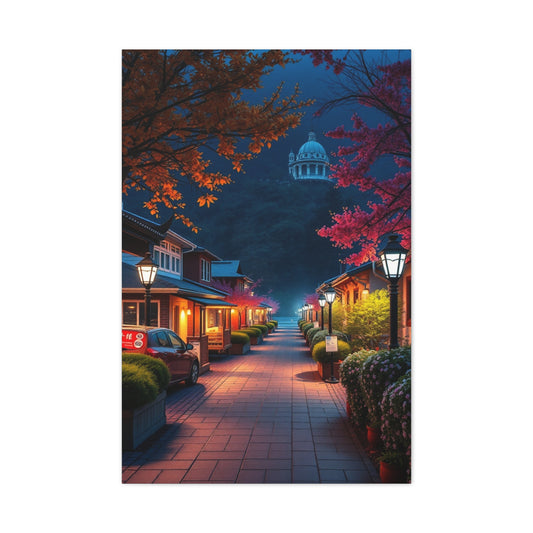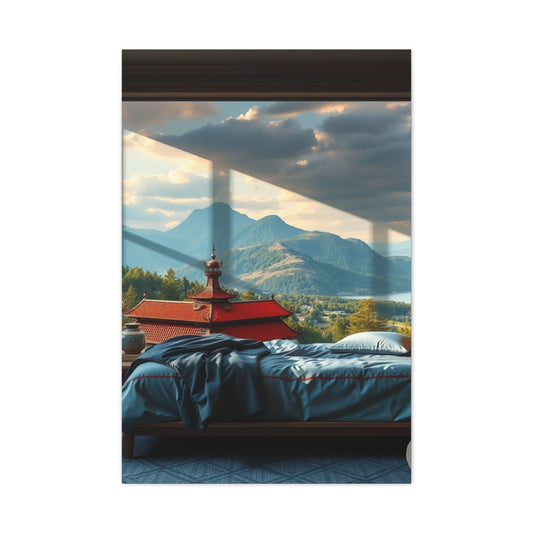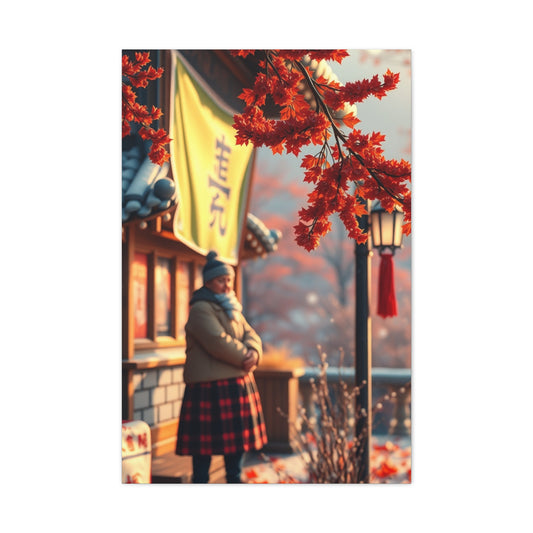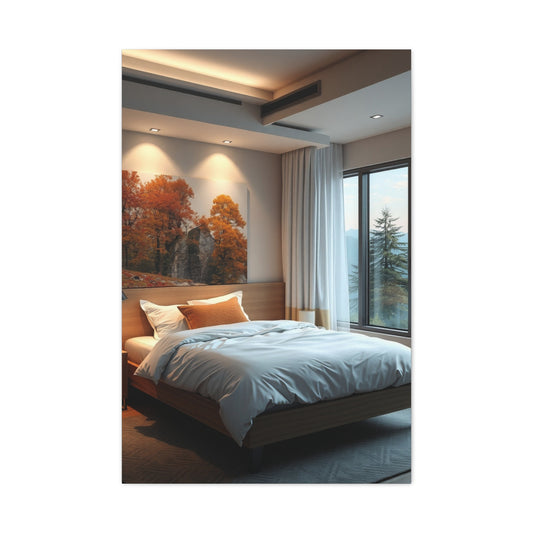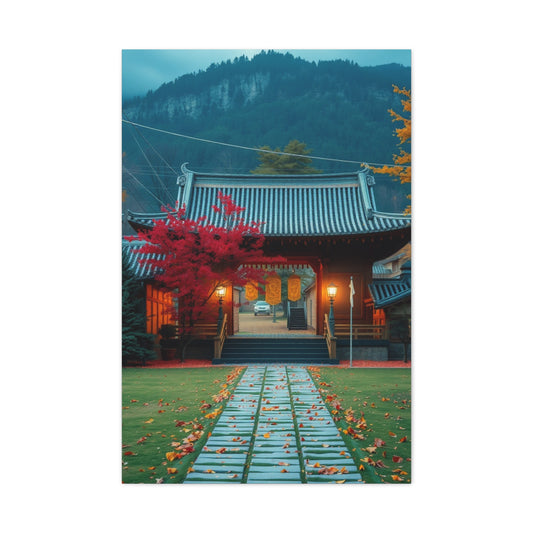Transforming your cherished digital photographs into captivating canvas prints is an intricate blend of artistry and precision. The magic of this transformation lies not just in the photograph itself, but in the meticulous decisions made during the entire printing process. A perfectly executed canvas print can elevate the ambiance of any room, adding depth and personality while immortalizing a precious memory. Whether you’re looking to enhance your home décor or give a thoughtful, personalized gift, understanding the fundamental aspects of canvas photo printing is essential. Here are the core principles to help you craft the perfect canvas print:
1. Selecting the Right Image: The Heart of Every Canvas Print
The image you choose is the cornerstone of your canvas print. This initial step cannot be understated, as it significantly influences the final result. It’s essential to opt for a high-resolution image that can maintain its clarity and vibrancy when enlarged. High-resolution images, typically 300 DPI (dots per inch), ensure sharpness and avoid pixelation when stretched onto a canvas. Ideally, the photo should evoke a strong emotional response and possess an inherent visual appeal. Consider images that resonate with you—whether a breathtaking landscape, an intimate portrait, or a moment frozen in time.
Beyond resolution, composition is key. A well-composed photograph with balanced elements creates a harmonious print. Focus on aspects like symmetry, leading lines, and the use of negative space. A crowded or cluttered image can detract from the aesthetic value of the canvas, making it feel overwhelming rather than soothing. Simplicity is often a secret ingredient in crafting powerful visual art, so aim for photos that naturally draw the viewer's eye to a specific focal point without distraction. Whether displayed as part of a single piece or as a collection of pieces in a gallery-style arrangement, the composition will significantly impact how your wallpics or any other canvas print resonates with viewers, ensuring it remains captivating and balanced in your space.
|
Related Catagories: |
2. Opt for the Right Canvas Size: Scaling the Image for Impact
Choosing the right size for your canvas print is a critical decision that influences both its visual impact and how it integrates with the space. The scale of your image should correlate with the dimensions of the room where the canvas will be displayed. For larger spaces such as living rooms or open-plan areas, oversized canvas prints can create a striking statement. These larger pieces often serve as focal points within a room, drawing attention with their grandeur.
Conversely, smaller spaces or more intimate areas, like bedrooms or personal workspaces, may benefit from more modest-sized prints. For an eclectic or modern look, don’t shy away from experimenting with different-sized canvases. A series of smaller prints arranged in a grid pattern can create a cohesive and dynamic display. Alternatively, a single, large canvas can dominate the room, making a bold and dramatic statement.
To ensure that the canvas fits seamlessly into your chosen space, measure the available wall area before finalizing your decision. It’s always a good idea to visualize how different sizes might look by using tools like digital mockups or print samples.
3. Cropping and Editing Your Photos: Refining the Visual Aesthetic
Once you have your photo, it’s time to refine it. Cropping and editing are essential steps to transform a good image into a great canvas print. Cropping helps eliminate unwanted distractions at the edges of the photo, drawing attention to the main subject. This adjustment can also improve the composition and balance of the image, ensuring it fits the dimensions of the chosen canvas size.
Beyond cropping, editing is the key to bringing out the best in your photo. Fine-tuning elements such as brightness, contrast, sharpness, and saturation will make your print pop. In many cases, a photo that looks striking on a digital screen might need adjustments to appear its best in print. Use photo editing software like Adobe Photoshop or Lightroom to enhance these qualities, and consider experimenting with filters or artistic effects for a creative touch.
Related Catagories:
For example, a portrait may benefit from softening the skin tones or increasing the sharpness around the eyes, while a landscape could be enhanced by boosting the contrast of the sky or emphasizing the vibrancy of natural elements like trees or flowers. The goal is to ensure that the colors and details appear crisp and vivid when printed on canvas.
4. Understanding Wrap Styles: Choosing the Best Presentation for Your Image
When it comes to preparing your photo for canvas printing, one of the most important decisions to make is choosing the right wrap style. The wrap style defines how the image is applied to the canvas and how its edges are handled, which ultimately influences the overall aesthetic and impact of the final print. Each style offers a unique visual experience, and understanding these options allows you to make a choice that best suits your artwork and desired outcome. Among the most popular wrap styles are gallery wraps and mirror wraps, each of which provides a different approach to displaying the image.
A gallery wrap is arguably the most popular and contemporary choice for canvas prints. This style involves stretching the image over the frame so that it wraps around the edges of the canvas. The result is a clean, modern look that eliminates any distraction from borders or framing. The image itself is the focal point, uninterrupted by external elements. This approach works particularly well for photos that contain ample background space or where the image itself has natural areas that can be extended over the sides without disrupting the composition. For instance, landscape photos with vast, open skies or wide horizons often benefit from gallery wraps, as the background flows seamlessly over the edges, creating a cohesive, continuous visual experience.
One of the significant advantages of the gallery wrap is that it provides a sense of depth and dimension. As the image stretches over the sides, it adds a sense of continuity and immersion, drawing the viewer’s eyes into the artwork, as if the image is unfolding in front of them. This style is especially effective for creating a striking visual statement in a contemporary setting, as it offers a streamlined and sophisticated appearance. Additionally, gallery wraps often eliminate the need for traditional framing, making them a sleek and minimalistic choice that complements modern interior design trends.
In contrast, mirror wraps offer a different kind of charm, particularly suited for images where continuity and flow are essential. This style involves duplicating the image’s outer edges and wrapping them around the canvas’s sides. The result is a seamless transition, allowing the image to extend around the frame without any abrupt interruptions. The mirrored edges often reflect the last portion of the photo, creating a harmonious blend between the front of the print and the sides. This method works exceptionally well for portraits, especially those with simple or neutral backgrounds, where the edges can be mirrored without disrupting the central focus of the image.
Mirror wraps are ideal for photographs where maintaining a consistent and uninterrupted visual flow is important. They offer a polished, professional look and are particularly effective for portraits, personal photos, or any artwork where the edges can blend naturally with the subject matter. The mirror wrap method can be used to extend a natural backdrop or maintain the integrity of a subject without introducing foreign elements. This wrap style creates a cohesive feel, as if the image is wrapping around itself, and can enhance the overall aesthetic by offering a smooth, uniform flow across the print.
Choosing between a gallery wrap and a mirror wrap ultimately depends on the specific image, the desired look, and the mood you wish to convey. If you're seeking a modern, minimalist feel, a gallery wrap may be your best option, allowing the image to take center stage with a clean, borderless presentation. On the other hand, if you're looking for a seamless, polished look that preserves the natural flow of the photo, a mirror wrap could be the perfect choice. By understanding these two options, you can select the wrap style that best enhances your photo and transforms it into a stunning piece of art that captures the essence of the moment.
5. Choosing the Right Canvas Material: Texture and Finish
The choice of canvas material is one of the most critical decisions in the process of creating a perfect canvas print, as it significantly influences both the texture and visual impact of your artwork. Canvas prints come in various finishes, each offering a distinct aesthetic and feeling, which can profoundly alter the mood of your image. Whether you're aiming for a timeless, understated look or a bold, contemporary feel, the material of your canvas plays a key role in achieving the desired effect.
Matte canvas, with its soft and refined finish, is ideal for those seeking a more traditional, classic appearance. Its subtle texture absorbs light rather than reflecting it, creating a muted, non-glare surface that allows the colors to settle into a more organic, serene feel. This finish is particularly well-suited for images that feature soft, natural tones or vintage photography. The lack of sheen adds an element of nostalgia, lending a rustic charm that transforms a photograph into something reminiscent of an older, hand-crafted piece of art.
In contrast, satin canvas strikes a balance between the refined elegance of matte and the vibrancy of glossy finishes. Offering a gentle sheen, it enhances the richness and depth of colors while still maintaining a level of subtlety that matte lacks. Satin canvas works wonderfully for images that require a sophisticated pop of detail, offering a modern, yet understated feel that elevates both the texture and the emotional resonance of the photo. The slight gloss in this finish makes it perfect for contemporary portraits or images that deserve attention but still maintain a sense of grace.
On the other end of the spectrum lies glossy canvas, a bold and dynamic option that introduces a high-shine surface perfect for those seeking maximum vibrancy. This glossy finish captures the light in a way that brings out every detail, making it ideal for bright, colorful images or those that demand attention. The dramatic contrast between the light reflections and the saturated colors makes glossy canvas a popular choice for high-energy, modern photography, especially when you want to create a statement piece that demands admiration.
Each canvas finish brings its own set of advantages, and selecting the right one depends largely on the image, the desired atmosphere, and the emotional undertone you wish to evoke. By carefully considering these elements, you can ensure your canvas print delivers both aesthetic appeal and lasting impact.
5. Customizing with Text or Graphics: Adding Emotional Depth
One of the most effective ways to transform a simple canvas print into a personalized, meaningful work of art is by adding text or custom graphics. This personal touch allows the print to convey more than just the visual. A well-chosen quote, the name of a loved one, or a significant date can imbue the canvas with an emotional layer, creating a deeper connection with the viewer. It can be a quote that reminds you of a special moment, or perhaps a phrase that embodies the spirit of the photo itself.
When incorporating text, it’s important to carefully select the font. The style of the font should align with the mood or theme of the image—whether it’s elegant, whimsical, modern, or classic. A cursive, handwritten-style font might complement an intimate, romantic photo, while a bold sans-serif font could enhance a modern, striking image. Ensure that the text is legible and well-balanced within the frame of the image. The size and positioning of the text are equally crucial—too small, and it may become lost; too large, and it may overpower the image. Aim for harmony between the photo and the text, especially when designing a wallpics print, where the integration of text and image must create a seamless, cohesive visual experience.
Moreover, adding custom graphics or illustrations can further personalize your canvas print, elevating it to a work of modern art. Subtle abstract elements, such as geometric shapes or organic motifs, can introduce a layer of complexity, creating a more contemporary and artistic flair. For instance, a photograph of a sunset could be accompanied by a delicate swirl or silhouette, adding depth and intrigue to the overall design.
Personalized graphics might also reflect the specific subject of the photo—such as adding floral designs to a nature print or a subtle vintage frame around a portrait. These additions don’t have to overwhelm the image but should rather complement it, adding nuance and a unique artistic touch that reflects your style.
7. Select the Right Frame for Your Canvas: Elevating the Overall Aesthetic
While canvas prints can stand alone, adding a frame can elevate the entire presentation, providing an added layer of sophistication and polish. The frame serves as the final element that ties everything together, enhancing the image while ensuring it blends seamlessly with the surrounding décor. Choosing the right frame requires careful thought, as it must complement the photo and fit with the overall style of the room.
|
Related Catagories: |
When selecting a frame, the first consideration is the style of the image. A minimalist, contemporary image might benefit from a sleek, thin frame in neutral tones like black, white, or metallics. These frames provide a subtle contrast that draws attention to the print itself rather than the frame. On the other hand, a vintage portrait might look beautiful in a more ornate, traditional frame made of wood or gold leaf, which adds character and historical depth to the piece.
Frame materials also play an important role. Wooden frames can add warmth and texture, creating a more organic, rustic feel, while metal frames often lend a more industrial or modern vibe. Consider how the frame material interacts with the print itself—does it enhance the mood, or does it detract from the image? The material of the frame should either match or provide a contrast that complements the colors and tone of the print.
Don’t be afraid to experiment with frame width as well. A thicker frame can create a more dramatic effect, drawing the viewer's eye towards the image, while a thinner frame allows the photograph to take center stage without distraction. If you’re unsure, narrow, neutral-colored frames tend to be the most versatile and universally flattering.
The Importance of Proper Framing: Adding Dimension and Style
Framing your canvas print is a final, but important, step in ensuring it has the desired impact. While many canvas prints are offered with gallery wraps, you may still want to add an external frame to further elevate the visual appeal. Framing not only adds an extra layer of sophistication but also protects the edges of the canvas from wear and tear.
Frames come in a variety of styles, from sleek and minimalistic to ornate and decorative. The frame should complement the image and the room’s overall design aesthetic. For a more contemporary look, consider a simple, black or white frame. For vintage or classical décor, consider gold or dark wood frames to bring warmth and richness to the piece. To make your canvas print truly unique, consider adding custom enhancements such as text or embellishments. Adding a meaningful quote, the date of an event, or the names of loved ones can turn a simple image into a personalized work of art.
Additionally, certain printing techniques can add a level of texture or depth to the canvas. UV coating or lacquer finishes can protect the print while adding a subtle, tactile finish. These add-ons can also improve the durability of the print, making it resistant to fading, scratches, and other environmental factors.
8. Editing Your Photos with Precision: Refining the Image for Perfection
Before sending your photo off to be printed, it’s vital to fine-tune the image using photo editing software. Even small adjustments can make a world of difference when it comes to the final result. Photo editing allows you to enhance the details and ensure that your print looks crisp and vibrant when enlarged. Software like Adobe Photoshop or Lightroom provides powerful tools for tweaking everything from exposure and contrast to sharpness and color saturation.
Related Catagories:
|
Breakfast at Tiffanys Characters Wall Art Canvas Photo Prints |
Start by adjusting the resolution to ensure your photo retains its clarity when stretched onto the canvas. A higher resolution will result in a sharper, more detailed print, which is essential when working with larger canvases. It’s important to avoid pixelation, so always choose images that are high enough quality to withstand enlargement.
Next, consider fine-tuning the colors and tones. Boosting the contrast or adjusting the brightness can help your print achieve more visual impact, while enhancing specific elements of the image. If your photo features vibrant colors, a slight increase in saturation will make those colors pop and bring the image to life. On the other hand, if your image is more subdued or minimalist, reducing saturation and adding a slight vignette can give it a more dramatic, moody look.
Additionally, removing distractions is key. Whether it’s an object in the background that distracts from the subject or a blemish that’s noticeable, using tools like the healing brush or clone stamp can clean up your image. You want the photo to remain as true to the original as possible, but with all the distractions minimized.
Editing is all about preserving the natural essence of the photo while enhancing its beauty. While it’s tempting to over-edit or use heavy filters, sometimes a lighter touch is best. Aim for subtle adjustments that highlight the unique qualities of the image without overpowering it.
9. Selecting a Reputable Printing Company: The Foundation of Quality
The quality of your final canvas print is inextricably linked to the reputation and craftsmanship of the printing company you choose. Not all printing companies are created equal, and it’s crucial to seek out a provider that is known for its high standards of work. A reputable company will use the best materials, employ advanced printing techniques, and ensure that the finished product is a true reflection of the image you’ve worked so hard to create.
One of the first factors to consider is the quality of materials the company uses. A high-quality canvas is not just about the texture and look—it’s about durability. Archival-quality canvas is a must, as it will preserve the print for years to come without fading or degrading. This type of canvas is designed to withstand the elements, from the dry air of a living room to the humid conditions of a kitchen, ensuring that your print retains its vibrancy and sharpness over time.
Moreover, look for a printing company that employs top-tier inks. High-quality inks, such as pigment-based inks, offer superior color accuracy and longevity compared to standard dye-based inks. These inks create a print that not only pops with richness and detail but also resists fading over the years. This is particularly important if you want your canvas print to last for generations, whether it’s a cherished family photograph or an artistic piece you want to pass down.
In addition to the materials and inks, it’s equally important to inquire about the company’s production process. Some companies specialize in color correction, ensuring that your print closely matches the colors you see on your screen. They may also offer custom framing, mounting options, and even photo touch-ups. These services can make a significant difference, turning a good print into a great one. If you choose a company that also offers a satisfaction guarantee, you can rest assured that you’ll have a final product you’re proud to display.
10. Hanging Your Canvas Print Properly: The Final Step in Displaying Your Art
Once your canvas print is ready, the next challenge is hanging it correctly to maximize both its aesthetic appeal and longevity. Proper installation ensures that your canvas print not only looks stunning but also remains securely in place for years. Additionally, hanging your print with the right technique can add to its overall visual effect, turning a simple photo into a striking work of art.
First, choose the right spot for your canvas. This decision is integral to the visual impact of the print. A general rule of thumb is to position the canvas at eye level—typically, the center of the print should be around 57-60 inches from the floor. This placement ensures that the print is comfortable to view and doesn’t require awkward positioning. If you're hanging multiple prints, ensure that there’s consistent spacing between each one to maintain balance and cohesion.
The wall surface also plays an important role in the overall effect of the print. A neutral-colored wall works best as it doesn’t compete with the artwork itself, allowing the print to stand out. Avoid hanging canvas prints in spaces with bold or overly busy backgrounds that might detract from the image. Also, consider the texture of the wall—smooth, flat walls provide the best foundation for hanging.
Once your canvas print is ready and beautifully displayed, it’s important to care for it properly to preserve its vibrancy and integrity. Hang your canvas print away from direct sunlight to prevent fading, and ensure it’s displayed in a space with moderate humidity to avoid warping.
Regular dusting is essential to maintain the texture and color of the canvas. Use a soft, dry cloth or a brush with gentle bristles to remove any dust or debris that accumulates on the surface. For deeper cleaning, consult the manufacturer’s instructions for safe cleaning methods to avoid damaging the print.
Next, select the right hanging hardware. Many canvas prints come with pre-installed D-rings, but if yours does not, it’s important to invest in high-quality hanging hardware. D-rings are excellent for evenly distributing the weight of the canvas across the wall, preventing any sagging or tilting over time. For larger canvases or heavier prints, opt for heavy-duty picture hooks or wall anchors. These ensure that the canvas stays securely in place, especially if it’s a large or particularly heavy piece. This is especially crucial for wallpics prints, where the quality and placement of the print are just as important as the durability and security of its display.
Additionally, take the weight of the canvas into account when selecting the right hardware. Larger prints can be quite heavy and may require more robust support. If you’re unsure, it’s always best to err on the side of caution and use stronger hooks, anchors, or even wires designed for heavier artwork. This will help prevent any unfortunate accidents where the print might fall.
In terms of the surrounding environment, consider the potential risks that can affect the integrity of the canvas print. Avoid hanging your print in places with excessive moisture, such as bathrooms or kitchens, where humidity can warp the canvas and damage the image. Similarly, avoid direct sunlight, which can cause the colors to fade over time. If your print will be exposed to sunlight, consider using UV-protective glass or coatings to mitigate the effects of fading.
The Technical Aspects of Printing and Hanging Your Canvas
When it comes to transforming a photo into a canvas print, creativity is key. However, once you’ve made those critical artistic decisions, it’s essential to focus on the technical side of the process to ensure that your canvas print not only looks spectacular but also stands the test of time. From selecting the right printing company to ensuring your canvas is hung in a way that maximizes its visual impact, every detail plays a role in making your canvas print a masterpiece.
Crafting Your Personalized Canvas Masterpiece
Enhancing your canvas print through personalization and fine details ensures that it is not only a representation of a photo but also a unique, emotionally resonant work of art. From adding meaningful text or graphics to selecting the right finish, frame, and edits, each decision plays a critical role in transforming a simple image into a timeless piece of art. By paying attention to these nuances, you’ll create a canvas print that tells your story in the most beautiful, personalized way possible—one that resonates with you and all who experience it.
Personalization and Perfection for Lasting Memories
Creating the perfect canvas print involves a balance of artistic vision, technical precision, and thoughtful attention to detail. From selecting the right image to choosing the perfect wrap style and material, each decision plays a crucial role in crafting a print that’s not only visually stunning but emotionally meaningful. By following these fundamental principles, you can ensure that your canvas print becomes a timeless work of art, enhancing your home décor and preserving your cherished memories for years to come. Whether for personal use or as a thoughtful gift, the ideal canvas photo print is a beautiful, lasting tribute to the moments that matter most.
Enhancing Your Canvas Print with Personalization and Fine Details
Creating a canvas print that stands out is an intricate process that requires more than just choosing the right photo. It is about enhancing that image, breathing life into it through personalized touches, thoughtful adjustments, and fine details that make the piece resonate deeply with those who see it. A well-crafted canvas print becomes more than just a decoration on a wall—it becomes a story, a piece of personal art that evokes emotions and memories. Here, we will explore how you can enhance your canvas print with personalized elements and fine details, ensuring it truly becomes a unique masterpiece.
Bringing Your Canvas Print to Life
From the initial creative decisions to the final hanging process, every step in the creation of a canvas print matters. By carefully selecting a reputable printing company, choosing the right materials, hanging your print properly, and maintaining it over time, you ensure that your canvas print not only enhances your space but remains a cherished piece of art for years to come. With the right technical considerations, your canvas print can truly become a timeless work of art that adds beauty and elegance to your home.
Creative Ideas and Final Thoughts on Canvas Photo Prints
Canvas photo prints offer an extraordinary opportunity to transform cherished memories into breathtaking works of art. Whether you're looking to decorate your living room, commemorate a special event, or gift someone a meaningful present, the possibilities with canvas prints are endless. In this final section, we will delve deeper into innovative ways to display your canvas prints and share final thoughts that will inspire your creativity and enhance your space.
Creative Ways to Display Multiple Canvas Prints
One of the most captivating ways to showcase your collection of images is by displaying them across multiple canvases to form a visual narrative. This approach allows you to tell a compelling story or communicate a theme through the synergy of different photos. For example, imagine a series of black-and-white portraits of family members, each canvas capturing a distinct expression or moment in time. When arranged thoughtfully, this collection becomes more than just a display of photos; it becomes a powerful representation of a family’s journey, emotions, and connection.
Alternatively, a travel-themed collage is a perfect way to immortalize the adventures you’ve experienced. Gather a selection of images from your travels, each capturing a different destination or moment from your journeys. By arranging these photos across multiple canvases, you can visually transport yourself and your guests to the far-flung corners of the world, each piece offering a unique perspective on the destinations visited.
For a more contemporary approach, consider using canvases to form a mural. This technique is particularly effective when working with a series of smaller canvases. By arranging them in a grid, a linear formation, or even a freeform pattern, you create the illusion of one large, unified piece of art. This not only amplifies the impact of your images but also fills your wall with dynamic visual interest. You can even add a personal touch by experimenting with irregular arrangements, such as an asymmetrical layout that evokes a more modern, artistic vibe.
Mixing Different Media: Combining Textures for Maximum Impact
Why limit yourself to just canvas when you can introduce a variety of media to enhance your display? By mixing acrylic prints, framed photographs, and even other textured materials, you can create a visually rich and tactile experience that goes beyond a standard canvas display. Acrylic prints, with their high gloss and vibrant colors, can provide a striking contrast to the matte, textured surface of canvas. When placed alongside a canvas print, the glossy finish of acrylic can make the images pop, adding depth and dimension to your arrangement.
Framed photos can also be incorporated into your display. Consider using them as accent pieces to highlight specific moments or themes within the larger canvas collection. These framed prints could serve as focal points, offering a contrast in framing styles and finishes, or they could blend seamlessly with the canvas prints, uniting the entire display under a cohesive aesthetic. By integrating different finishes and materials, you transform your display into a sophisticated, multi-dimensional art installation that engages viewers on multiple levels.
Conclusion
Crafting the perfect canvas print isn’t just about selecting the right photo; it’s about exploring the boundless potential of your creativity. From the photo you choose to the way it’s displayed, each decision you make contributes to the emotional resonance and visual appeal of the final piece. Whether you opt for a minimalist portrait, an abstract collage, or a thematic mural, the end result will be a reflection of your unique personality and artistic taste.
Take the time to experiment with various arrangements, finishes, and media combinations. Don’t be afraid to try something unconventional—after all, art is about expressing what matters to you. The process should be an enjoyable journey where you allow your imagination to flow freely, crafting not just a print but a piece of art that enhances your space and elevates your everyday environment.
When it comes to gifting, canvas prints are unparalleled in their ability to convey emotion and thoughtfulness. Whether it’s a personalized photo of a loved one, a meaningful quote, or a beautiful landscape that holds sentimental value, canvas prints turn ordinary memories into extraordinary treasures. They are the perfect gift for weddings, anniversaries, birthdays, or simply to celebrate the milestones and special moments in life. A wallpics canvas print can be especially impactful, offering a personal touch that will be cherished for years to come.
Ultimately, canvas photo prints are more than just decoration; they are expressions of love, joy, and personal significance. Take the time to explore new ways of presenting your photos and make sure to infuse each piece with your own artistic flair. In doing so, you’ll create not only a stunning visual impact but also lasting memories captured in the form of timeless, cherished art.









